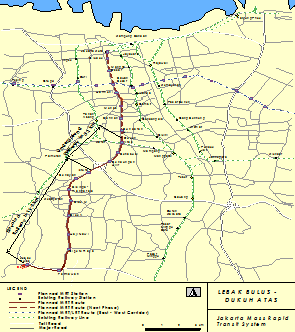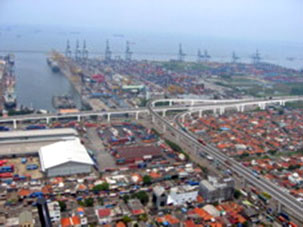
| ENGLISH |  |
BAHASA INDONESIA |  |
日本語 |
|
Outline of Japan's ODA Activity in Indonesia in Individual Sectors
 Transportation Transportation
Japanese Assistance Supports the Improvement of Transportation and Distribution Networks in Indonesia
Indonesia is the largest archipelago country in the world with more than 17,000 islands which are spread in the distance of about 5,000 kilometers from east to west (almost as wide as the United States) and about 1,900 kilometers from north to south. The population is over 200 million (fourth in the world) with more than half of it concentrated in Java which accounts for only about seven percent of the total area of the country. For Indonesia to achieve a balanced and stable economic and social development, it is urgent to connect the islands spread over a vast expanse and to build an efficient transportation network in the highly populated Java island and in particular, in the metropolitan area of Jakarta. In recent years, especially, the traffic congestion in the metropolitan area of Jakarta, the center of politics and economy, has become very serious. In order to further attract overseas investment to help the economy to grow, improvement of the transportation system between air and sea ports and industrial complexes as well as public transportation system are required. In the transportation system of Indonesia, aviation and coastal shipping connecting different islands, railways, highways and general trunk roads in Java and general trunk roads outside Java play a major role. In its loan aid, Japan attaches priority to assistance for improving transportation networks with main focus on alleviation of traffic congestion and improvement of goods distribution in the metropolitan area of Jakarta, and improvement of transportation networks between major cities. In the metropolitan area of Jakarta where traffic congestion is becoming very serious, Japan has been assisting construction of railways, highways and flyovers at intersections which has become a bottleneck. To cite some examples, Japan provided assistance for construction of a flyover at the Semanggi intersection which has now become a landmark of Jakarta, the “Merak Expressway”, the “Jagorawi Expressway” which connects Jakarta and Bogor, improvement of the “Jabotabek Railway Networks“, and the elevation of rail tracks and the Gambir Station which serves as the terminal for short distance trains. Recently, Japan has started assistance for development a new public transportation network in the metropolitan area of Jakarta through the “Jakarta Mass Rapid Transit (MRT) project”, the first subway project in Indonesia. Through the MRT project, Japan aims to realize a comfortable and safe subway system that suits the capital city of Indonesia using Japanese technology and experience. In order to facilitate a modal shift to the public transportation system, Japan will present proposals and assistance on the future shape of Jakarta by introducing a new concept of a “rail station” that combines commercial activities such as shopping and business functions.
In addition, Japan has provided assistance to the construction of the access road to Tanjung Priok Port (part of the second outer ring road of Jakarta), renovation of the Tanjung Priok Port and the improvement of the roads around industrial complexes in an effort to improve the transportation of goods between the industrial complexes in the eastern part of Jakarta and the Tanjung Priok Port. Through such assistance, Japan contributes to making Indonesia attractive to foreign investors, while raising the income level through productivity enhancement and job creation.
In order to create an efficient inter-city transportation system in the densely populated Java in which many large cities are located, it is vital to increase the capacity of land transport such as roads and railways. With respect to railways, the Java mail railway line, which connects Jakarta and Surabaya and other major cities, is currently in the process of being double-tracked. Using loan aid, Japan assists the railway double-tracking between Jakarta and Yogyakarta but for certain sections. As the result of the double-tracking, the time required for railroad transport between Jakarta and Cirebon has already been reduced. With respect to roads, Indonesia is currently in the process of improving the “trans-Java expressway”. Japan is working to further improve transportation within Java, by assisting the expansion and safety of railway transportation between the major cities of Java. In its effort to connect major cities in different islands, Japan has provided assistance to the development of airports through loan aid. Japanese assistance has contributed to the development of the airport of Surabaya, the second largest city of Indonesia; the airport of Palembang and Padang, major cities of South and West Sumatra respectively; the airport of Balikpapan, a major city of Kalimantan; International Airport in Bali, one of the two major gateways to Indonesia. Japan has also provided assistance to the ferry terminals in Merak and Bakahuni which connect Java and Sumatra islands, contributing to ensure and expand ferry transportation along major routes. |
|


 Return Top
Return Top

